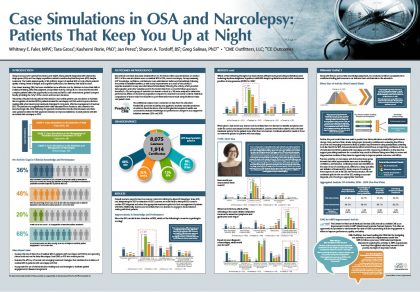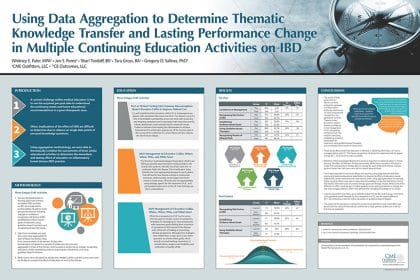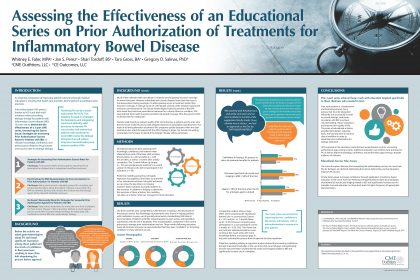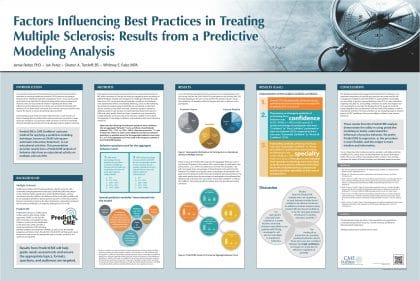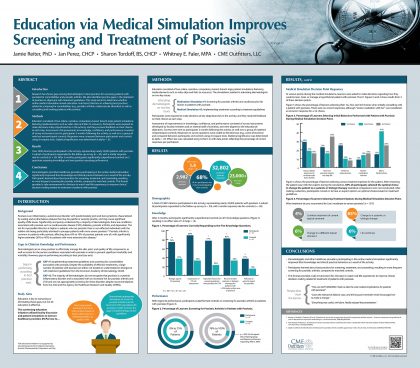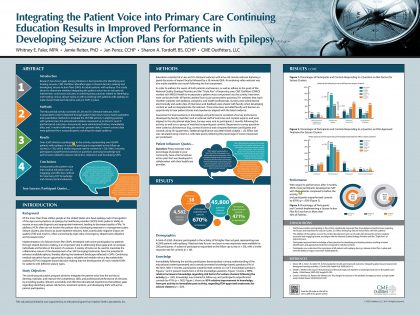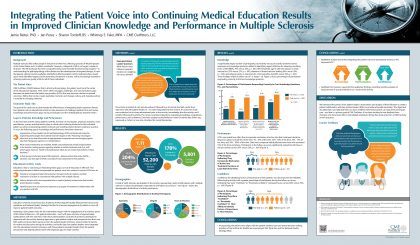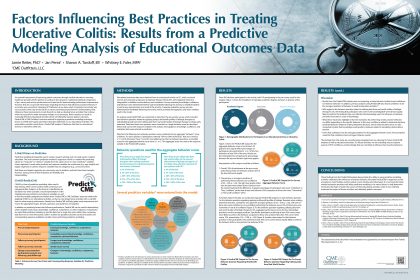CME Matters….
and So Do The Results
As the landscape of continuing medical education is innovating and improving, so are the results of the education … and we can prove it. In today’s healthcare environment, it is more important than ever to know exactly what impact CME is making on clinical practice, and on the lives of patients over the globe.
We collaborate with national healthcare organizations, KOL’s, and local associations to address health care quality gaps every day. In alignment with the national standards for quality CME, our team embraces a mixed-method educational outcomes approach that tackles the current practice challenges in neurology, psychiatry, primary care, inflammation, immunology, and infectious disease.
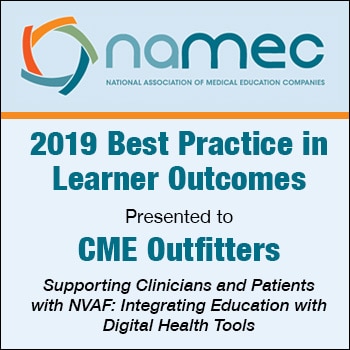 Click on the tabs on the left side of the page to see why our CME matters to improving patient care.
Click on the tabs on the left side of the page to see why our CME matters to improving patient care.
CME Outfitters’ Outcomes Recognized at Industry and Scientific/Medical Meetings
Sleep is necessary for optimal functioning and health. Many patients diagnosed with obstructive sleep apnea (OSA) and narcolepsy experience residual excessive daytime sleepiness (EDS) despite treatment. Case-based learning (CBL) has been established as an effective tool for clinicians to hone their skills in analytical thinking, reflective judgement, and problem-solving. Using CBL in a branched format with complex patients offers the opportunity to succeed and fail in a safe environment, guided by expert faculty providing the “why” of the correct and incorrect decisions.
Implications of the effect of CME is difficult to determine due to reliance on single data points of pre-post knowledge questions. Using aggregation methodology, we were able to thematically combine the assessments of three similar educational activities to determine the immediate effect of education on IBD practice.
Prior Authorization (PA) poses a burden to healthcare providers (HCPs) and their staffs when prescribing biologic therapy for patients with IBD. Our aim was to determine the effectiveness of three CME activities on clinician knowledge, confidence, and performance related to PA processes and success rates for biologic therapy.
Multiple sclerosis (MS) strikes people in the prime of their lives, affecting upwards of 400,000 people in the United States and 2.5 million worldwide while healthcare providers (HCPs) treating these patients are faced with a continually changing treatment landscape. We used predictive modeling to determine factors that influence HCP practice behaviors to gain a better understanding of barriers preventing best practice implementation.
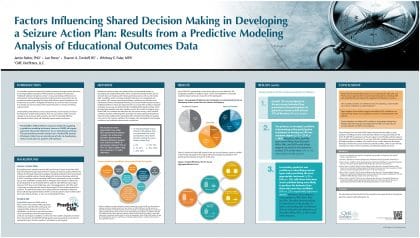
Presented at: American Epilepsy Society Annual Meeting – December 1-5, 2017 – Washington, DC
We applied our unique predictive modeling offering, PredictCME, to data from an educational activity on epilepsy. We wanted to see what factors influenced clinician behavior related to implementing shared decision-making to develop a seizure action plan for patients with epilepsy. Click on the link to find out what were the strongest predictors of this practice behavior!
Presented at:
– Orlando Derm Aesthetic & Clinical Conference – January 13-16, 2017 – Miami, FL
– Maui Derm Meeting – March 20-24, 2017 – Maui, Hawaii
We incorporated medical simulation into an activity on psoriasis to provide an engaging and real-life experience for learners. Educational outcomes analysis revealed up to 235% more participants than controls obtained correct responses on knowledge questions, and 429% more participants implemented a best practice behavior, clearly demonstrating the success of this format.
Presented at:
– ACEhp Annual Meeting – January 26-29, 2017 – San Francisco, CA
– ANA2017 – October 15-17, 2017 – San Diego, CA
Integrating the patient voice into educational content provides clinicians with an opportunity to hear patient experiences aligned with the latest evidence. Results from educational outcomes analysis on an activity in epilepsy demonstrated this to be an impactful approach, with participants outperforming controls on knowledge by up to 471%, and on behavior by 450%.
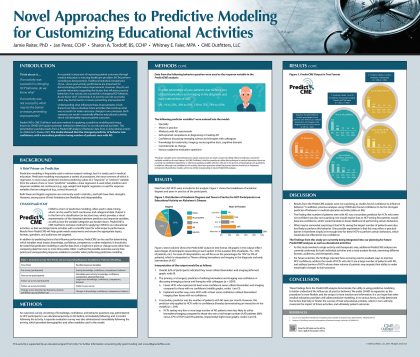 Novel Approaches to Predictive Modeling for Customizing Educational Activities
Novel Approaches to Predictive Modeling for Customizing Educational Activities
Presented at:
– IME Conference – February 24-25, 2017 – San Gabriel, CA
– WGEA Spring Meeting – February 25-28, 2017 – Salt Lake City, UT
– SACME Annual Meeting – May 16-20, 2017 – Scottsdale, AZ
CMEO’s unique offering, PredictCME, is based on a predictive modeling technique known as CHAID, which enables a visually-intuitive tree-based output. We applied this method to outcomes data from an activity on Alzheimer’s disease and found two significant predictors of practice behavior. This information will be used to help maximize the impact of future activities.
Presented at:
– CMSC Annual Meeting – May 24-27, 2017 – New Orleans, LA
– ANA2017 – October 15-17, 2017 – San Diego, CA
We believe the patient must be at the center of all CME. We engaged an advisory panel of MS patient leaders to gain insight into the patient perspective and incorporate that into the educational content. Educational outcomes analysis showed this method to be successful in MS, with up to a 480% improvement in knowledge, a 204% improvement in performance, and a 195% improvement in confidence.
Integration of Patient Engagement Intervention into Psoriasis Medical Education Programming to Increase Awareness and Improve Patient Outcomes
Presented at:
– Fall Clinical Dermatology Conference – October 12-15, 2017 – Las Vegas, NV
Based on a CME activity featuring interviews with faculty experts in psoriasis and 12 weeks of direct patient engagement through Pack Health, CMEO aimed to educate both HCPs and their patients in order to improve overall care and well-being. PROMIS (patient-reported outcomes measurement information system) assessments administered before and after the program revealed statistically significant improvements from baseline to Week 12 inpatient mental health (p = .003), physical health (p = .012), and confidence to manage psoriasis symptoms (p = .008).
Presented at:
– ACG2017 – October 13-18, 2017 – Orlando, FL
An interactive and innovative case series inspired this study. Infographics were integrated to facilitate content delivery and translation, and surveys assessing knowledge, confidence, and behavior were administered before and after the activity. Demographics, knowledge, confidence, and evaluation data were entered as predictors, and findings revealed confidence to be the strongest predictor of the behavior score, which was determined based on two questions that reflected individualizing treatment and initiating early treatment.
Press Releases
CME Outfitters Accepts 2018 Award for Best Practice in innovative Educational Methods (1/25/19)
Poster Accepted at 2018 Annual Meeting of the Associated Professional Sleep Societies (2/13/18)
Poster Accepted at 2017 Advances in Inflammatory Bowel Diseases (AIBD) Conference (1/4/18)
Posters Accepted at CNS Summit 2017 and NANS 2018 Meetings (10/31/17)

